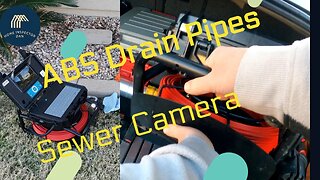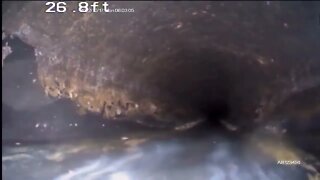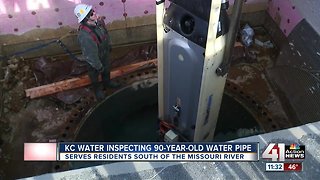Home Inspector finds crushed Orangeburg drain pipes with sewer camera
Orangeburg pipes, also known as bituminous fiber pipes, were a type of sewer and drain pipe commonly used in residential plumbing systems in the mid-20th century, particularly from the 1940s to the 1970s. Here are some key points about Orangeburg drain pipes:
Material: Orangeburg pipes were made from layers of wood pulp and pitch (a form of coal tar). The layers were pressed and saturated with hot bitumen or asphalt, giving the pipe its distinctive appearance and flexibility.
Flexibility: One of the notable characteristics of Orangeburg pipes was their flexibility. This made them relatively easy to install as the pipes could bend and conform to the trench shape without requiring as many joints or fittings as rigid pipes.
Lightweight: Orangeburg pipes were lightweight, making them easier to handle and transport compared to other types of drain pipes, such as cast iron or clay.
Lifespan and Durability: Unfortunately, Orangeburg pipes have a reputation for being relatively short-lived and prone to various issues. Over time, the material could deteriorate and become brittle. The pipe's structural integrity could be compromised due to crushing, collapsing, or deformation, leading to leaks, blockages, and potential sewer line backups.
Vulnerability to Tree Root Intrusion: One significant issue with Orangeburg pipes was their vulnerability to tree root intrusion. The pipe's composition and flexibility made it more susceptible to invasion by tree roots seeking moisture. Root infiltration could cause blockages and further damage to the pipe, leading to a compromised drainage system.
Replacement: Due to the inherent issues associated with Orangeburg pipes, it is often recommended to replace them with more durable and long-lasting materials, such as PVC (polyvinyl chloride) or ABS (acrylonitrile butadiene styrene) pipes.
If you suspect that your plumbing system contains Orangeburg pipes or are experiencing problems with your drain lines, it is advisable to consult a professional plumber. They can assess the situation, identify the type of pipes in your system, and provide appropriate recommendations for repairs or replacements based on your specific needs.
Efflorescence is a crystalline deposit that forms on surfaces when water-soluble salts are carried to the surface through water evaporation. Here are a few possible causes and explanations for the white buildup:
Mineral Deposits: Water naturally contains minerals like calcium, magnesium, and various salts. When water evaporates from the surface of the drain pipes, these minerals can be left behind, resulting in a white residue.
Hard Water: If you live in an area with hard water, which contains high levels of dissolved minerals, it can contribute to the formation of white deposits over time. The minerals in the water can accumulate inside the pipes and create the buildup.
Leaking Sewer Lines: If there are leaks or cracks in the sewer lines, moisture can escape and cause the surrounding soil to become saturated. As the water evaporates, it can carry salts from the soil onto the surface of the pipes, leading to efflorescence.
Fertilizer or Chemicals: If you use fertilizers or chemicals in your yard, the runoff from irrigation or rainwater can carry these substances into the drain pipes. Over time, they can leave behind a white residue as the water evaporates.
While efflorescence itself is not typically harmful, it can be an indication of underlying issues. If you notice a significant buildup or if it is accompanied by other symptoms like foul odors or slow drainage, it may be advisable to consult a plumber to inspect your drain pipes. They can assess the situation and determine if there are any structural issues or clogs that need to be addressed.
Additionally, regular maintenance and cleaning of your drain pipes can help prevent the buildup of minerals and reduce the occurrence of efflorescence. A professional plumber can provide guidance on the best methods for cleaning and maintaining your specific drain pipe system.
-
 8:10
8:10
Home Inspector Dan
1 year agoDrain evaluation with sewer scope camera during home inspection in Mesa, AZ
103 -
 8:02
8:02
Home Inspector Dan
1 year agoDrain camera inspection on a 4 year old ABS sewer pipe with no issues but some toilet paper.
12 -
 3:11
3:11
Fix It Yourself!
9 months agoMain House Drain Stack Pipe Repaired by Professionals - Know Your Limits
42 -
 18:16
18:16
TheWayIDidIt
1 year agoRV Sewer Tank Drain_ 2 outlets to 1
2 -
 1:51
1:51
KSHB
5 years agoKC Water inspecting 90-year-old water pipe
2 -
 23:21
23:21
Rob's Aquatics
1 year agoI Found A DRIED UP SEWER Filled With AQUARIUM FISH!
5 -
 2:08
2:08
Peter von Panda
6 years agoThe Easiest Way to Treat Your Septic Tank is with Dissolvable Easy Flush Live Bacteria Packets
41 -
 1:26
1:26
Inhouse Plumbing Company
1 year agoCast Iron Sewer Pipe Replacement
11 -
 3:15
3:15
SeidelRanch
1 year agoCamera Finds Clog - Articulating Borescope In Drain Pipe
12 -
 0:07
0:07
wiscontech
1 year agoplastic pipe CRUSHING